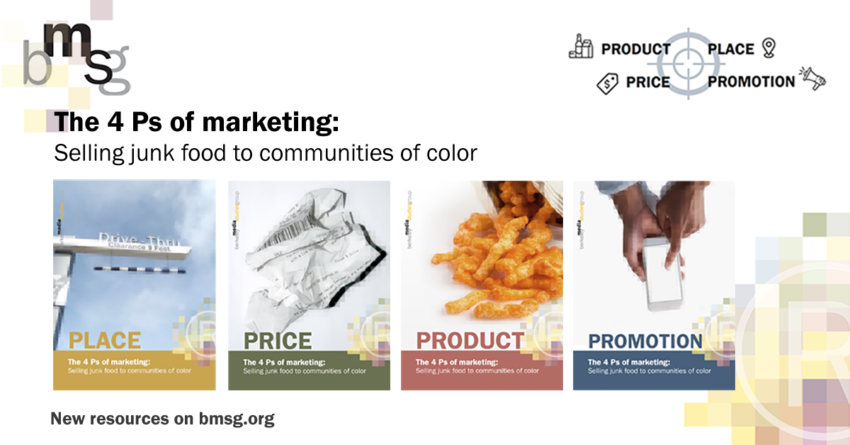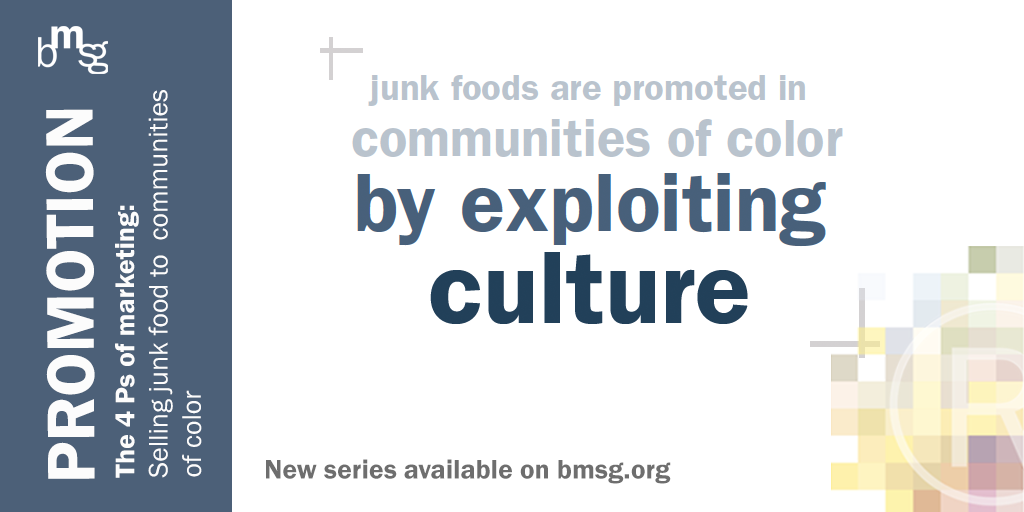
Share On Social!
Targeting foods and drinks high in sugars, salt, and fats to Latinos and communities of color contributes to health inequity.
To improve the nutritional quality of products that are directed toward and sold to Latinos and communities of color, advocates need to understand marketing strategies used by the food and beverage industry.
A new series of four briefs from Berkeley Media Studies Group (BMSG), The 4 Ps of Marketing: Selling Junk Food to Communities of Color, explains how each marketing principle works and provides examples to illustrate how target marketing contributes to health inequities.
For example, food and beverage companies use marketing tactics founded on the “marketing mix” principles of the 4 Ps—product, place, price, and promotion—to target Latino kids and kids of color with junk food marketing.
“Targeted marketing is a health equity issue—one that needs a public health response,” BMSG Director Lori Dorfman said in a recent statement. “Soda and fast-food companies have been following the tobacco industry’s lead and using many of the same marketing practices with the explicit goal of increasing junk food consumption among African Americans and Latinxs.”
Place
Although companies routinely use their physical presence to market and sell unhealthy products to communities of color, these companies expand where their products are seen, used, and purchased.
Companies use ethnic festivals and other events in communities of color to promote junk food.
For example, during Miami’s Calle Ocho 2015 festival, which celebrates the city’s Latino community, Coca-Cola banners and logos covered the streets. This isn’t the first time Coke targeted Latinos. Coke has more than doubled its Spanish-language TV advertising between 2013 and 2017.

Moreover, “place” is becoming more and more virtual, and companies are using geolocation technology to detect nearby shoppers and send personalized ads.
Even in situations where the actual transaction doesn’t happen online, the initial place potential clients are converted to actual clients is online.
Marketers can now understand and use a person’s entire location history to target junk food to Latinos.
Price
Price discrepancies between healthy food and junk food is not simply a function of market supply and demand.
Low costs are a strategic marketing tactic to attract people from low-income communities, often predominately Latinos and communities of color.
The price of food is associated with food purchasing decisions and consumption; thus caloric intake and health, as many of the foods and beverages sold at low prices are low in nutrients and high in sugars, salt, and fats.
“These junk foods can increase disease risk or interfere with management of chronic conditions — especially in the absence of healthier food and beverage options,” the report states.
Low-income communities are often plagued by food deserts and food swamps simultaneously, meaning they lack affordable grocery stores while facing an abundance of fast-food restaurants and convenience stores.
These families will come across bottled water that is more expensive than soda and food staples, like eggs, milk, and apples, that are more expensive than Cheetos.
Product
Product development is one of several ways that companies engage in target marketing.
Pepsi Limón, Doritos Salsa Verde, and Tapatío hot sauce-flavored Fritos, for example, were created to attract Latino consumers.
Because youth of color are deemed as trendsetters, products are often created specifically for them.
“While there are benefits to food and beverage companies being inclusive with the products they offer and appealing to many cultures and ethnicities, doing so becomes a problem when such products are unhealthy,” the report states.
Promotion
Junk foods are promoted in communities of culture by exploiting cultural sensibilities and using images, symbolism, and language.
Junk food companies exploit youths of color as brand ambassadors, mom bloggers as “top tier influencers” and celebrities of color while employing communities of color, supporting Black charitable organizations, and sponsoring important social programs, like college scholarships for Latino students.

Youths of color are disproportionately impacted by digital marketing because they more frequently use smartphones and mobile technology.
Influencer marketing is particularly underhanded, in that it is always happening. Moreover, children and teens may not realize that they are being advertised to.
Starbucks and Taco Bell, for example, are designing menu items specifically for influencer campaigns on Instagram.
“Supporting communities — especially those that have been historically neglected or discriminated against — is important, but it doesn’t give companies free rein to market their products that do the most harm,” the report states.
The food and beverage industry uses the 4 Ps together to promote unhealthy products at carefully set prices to Latinos online and in specific neighborhoods.
What Can We Do?
Below are recommendations to push food and beverage companies to stop aggressively marketing their least healthy products to communities of color.
Policy:
- Lawmakers should enact federal and state privacy policies and digital consumer policies that would restrict food marketing strategies related to geotracking.
- Cities could create tracking- and targeting-free zones that shield targeted populations from marketing for junk food and other unhealthy products.
- Companies’ inventory of tactics for targeting communities of color should be documented, publicized, and, where possible, used to engage in constructive industry discussion.
Advocacy:
- Public health and community groups should continue to educate journalists so they can document how food and beverage companies engage in state-of-the-art research — such as digital ad testing and measurement, mobile phone focus groups, and digital panels tied to multicultural audiences — to help marketers understand communities of color and create appealing, unhealthy products and brands.
- Advocates should create or support community-based education and advocacy campaigns that explain the practice of target marketing, as well as show how the issue is linked to civil rights concerns related to discrimination and unfairness.
- Advocates can help by developing or joining public campaigns to hold food and beverage companies — and those selling marketing data to them — accountable.
- Advocates could encourage restaurants to participate in the Children’s Food and Beverage Advertising Initiative, which ensures minimum nutrition standards for foods marketed to kids.
- Community leaders could ask whether companies are spending as much to market nutritious products as they are to promote salty, sugary, high-fat products; they could also organize digital app opt-out campaigns in communities of color to counter low-cost junk food promotions and send a message to the industry.
- Urge companies to reformulate their products to improve their nutritional quality.
Share this resource with health and equity advocates to combat the all-too-common practice of target marketing junk food to Latinos and communities of color.
Explore More:
Healthy FoodBy The Numbers
1
Supermarket
for every Latino neighborhood, compared to 3 for every non-Latino neighborhood



